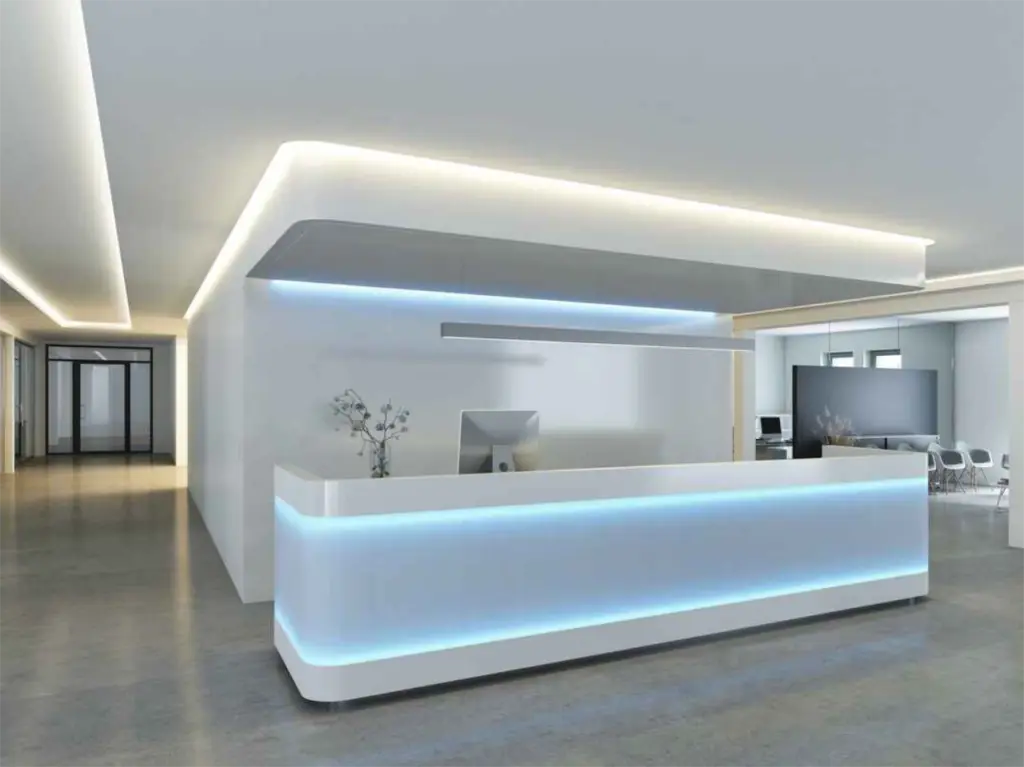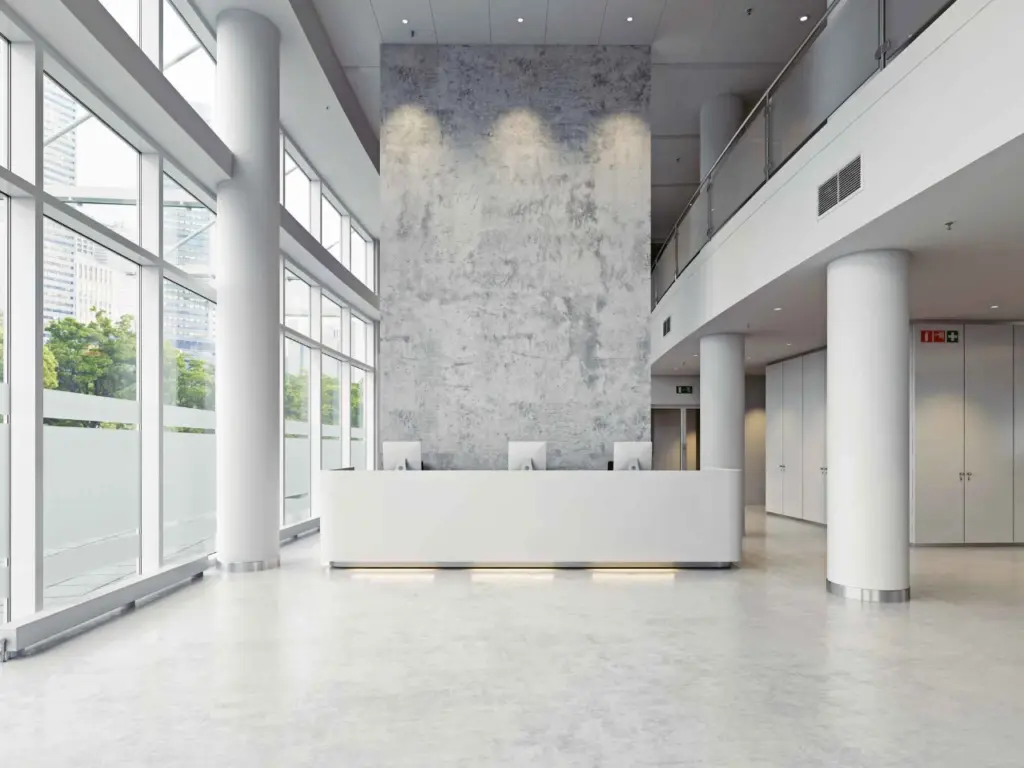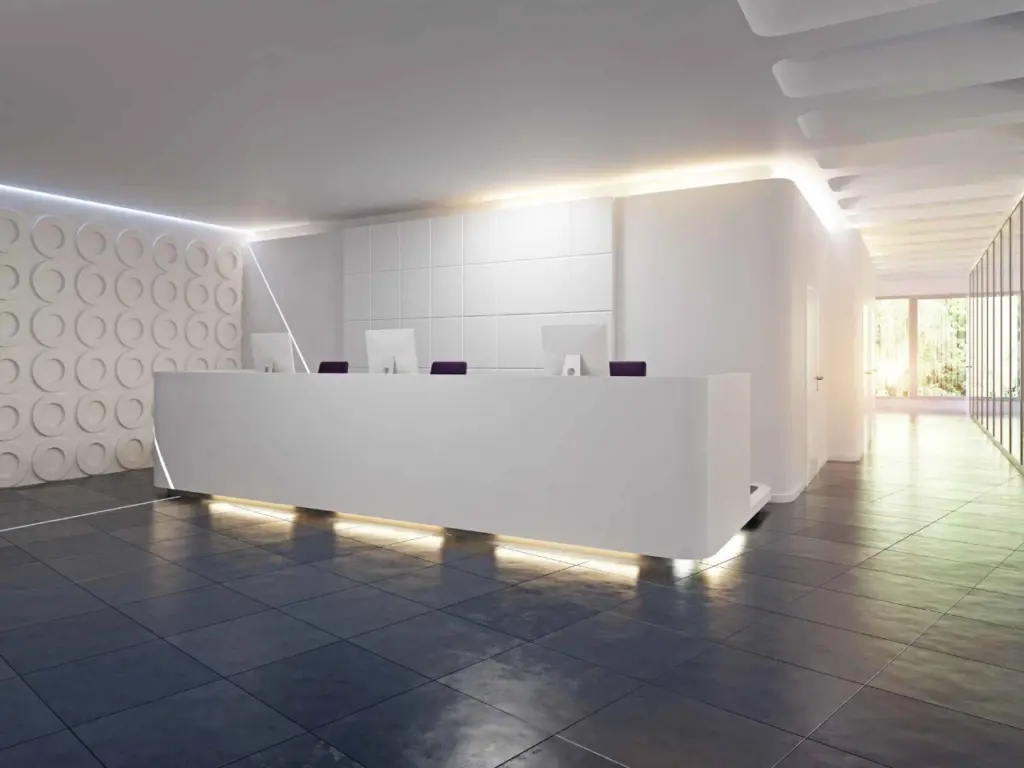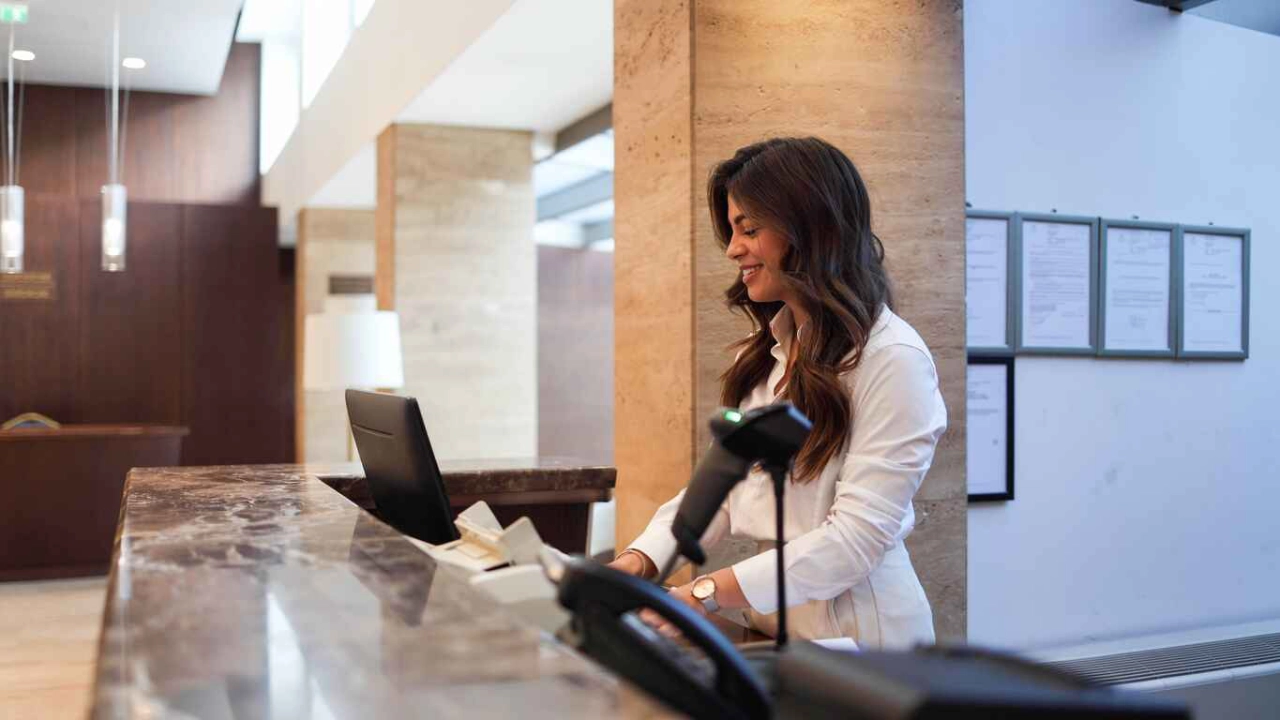How important is the height of your reception desk in creating a lasting first impression? A well-designed reception desk can make or break the first impression of your office.
Whether it’s welcoming clients, supporting a busy receptionist, or setting the tone and style for your brand, the height of the reception desk for your office plays a crucial role.
In this guide, we’ll show you the recommended reception desk dimensions, explaining how to find the perfect height for your reception that combines functionality, style, and ergonomics.
Read on to discover everything you need to know to ensure the desk fits your office needs while leaving a lasting impression on your visitors.
What is the Standard Height for a Reception Desk?

When designing a reception desk, understanding the standard height guidelines is vital for ensuring both functionality and design. The reception desk height plays an important role in the comfort of the receptionist and the overall appeal of your reception area.
A typical reception desk height usually falls within the following ranges:
- Seated Receptionists: The desk height is typically between 28 to 30 inches. This range allows for comfortable sitting positions, ensuring that the receptionist can work efficiently without straining their back or shoulders. It aligns with ergonomic principles, promoting good posture and reducing physical strain during long hours of work.
- Standing Receptionists: For receptionists who work while standing, the desk height is typically around 42 inches. This height is ideal for maintaining a comfortable posture while interacting with visitors, allowing for easy access to documents and other work materials without bending over excessively.
Why Does Reception Desk Height Matter?

The height of a reception desk is crucial because it directly influences both the workspace and the interaction between your receptionist and visitors. Receptionists typically spend long hours behind the desk, and the wrong desk height can lead to physical strain, reducing productivity and affecting the first impression visitors have of your office. The height of your reception desk influences several key factors:
- Comfort and Ergonomics: A desk that is too low can lead to discomfort and poor posture for the receptionist, potentially resulting in musculoskeletal issues. Conversely, a desk that is too high can feel imposing and create an uncomfortable interaction for both the receptionist and visitors.
- Aesthetic Appeal: The height of a reception desk affects the overall look of your reception area. A well-proportioned desk that matches the scale of the space and other office furniture contributes to a cohesive and welcoming design. An ill-suited desk height can disrupt the visual harmony and make the space feel unbalanced.
- Functionality: A desk with the appropriate height ensures that the receptionist can perform their tasks efficiently. It facilitates easy access to paperwork, computers, and other essential items, contributing to smoother operations and a more professional atmosphere.
By following these standard height guidelines, you strike the right balance between style and practicality, creating a reception desk that enhances both the functionality of your workstation and the overall first impression of your office.
The 3 Types of Reception Desk Heights

Getting the proper height for a reception desk is important for ensuring comfort and functionality. Different desk heights cater to various needs and office environments.
Standard Height Desk
A standard height reception desk is commonly designed to accommodate most users comfortably when seated.
- Height: Usually 28 to 30 inches (71 to 76 cm) from the floor.
- Features: This height supports a natural arm position for tasks like typing or writing while seated.
- Ideal Use: Suitable for traditional office environments where the reception desk is primarily used by receptionists who remain seated.
Adjustable Height Desk
An adjustable-height reception desk offers flexibility for both sitting and standing positions.
- Height Range: Generally between 24 to 50 inches (61 to 127 cm) from the floor.
- Features: This desk can be adjusted to different heights to accommodate various working postures and ergonomic preferences.
- Ideal Use: Best for active office settings where employees may alternate between sitting and standing throughout the day.
High Counter Desk
A high counter desk provides a standing-height surface for fast interactions.
- Height: Typically 36 to 42 inches (91 to 107 cm) from the floor.
- Features: This desk is designed for standing use, often resembling a bar or counter setup.
- Ideal Use: Perfect for reception areas where brief interactions are common, such as busy service counters or customer service stations.
Having the right desk height enhances both functionality and user comfort, ensuring that the reception area meets the needs of its users effectively.
Ergonomics and Reception Desk Design: How to Ensure Comfort

Ergonomics is vital in designing a reception desk to secure the comfort and well-being of the receptionist. Poorly designed desks can lead to discomfort, fatigue, and poor posture.
To achieve an ergonomic design:
- Desk Height: The reception desk height should allow the receptionist to keep their elbows at a 90-degree angle when typing, promoting proper posture.
- Adjustable Seating: Use adjustable seating options like an office chair or stool to accommodate different heights and ensure comfort.
- Legroom: Ensure ample legroom under the desk to allow for a comfortable sitting position and reduce physical strain.
Enforcing these ergonomic principles helps create a reception desk that supports the receptionist’s comfort and productivity.
Choosing the Perfect Height for Your Reception Desk

Finding the proper height for your reception desk is essential for ensuring both comfort and style not only in your reception area but also in your entire office space. Here’s a guide to help you make the best choice:
Standard Heights
- Seated Receptionists: The ideal desk height for seated receptionists is usually 28 to 30 inches. This height suits most office chairs and supports ergonomic working conditions.
- Standing Receptionists: For those using a standing setup, the recommended height for a reception desk is between 34 and 42 inches. This range provides a comfortable interaction level for both the receptionist and guests.
Key Considerations
- Receptionist Tasks: Evaluate the tasks performed. If extensive typing or paperwork is involved, an adjustable desk might be beneficial for ergonomic comfort.
- Space and Ergonomics: Ensure the desk height suits well within your reception area and allows for a neutral, comfortable posture. Good ergonomics will help maintain productivity and reduce strain.
Additional Tips
- Customization: Consider customizing the desk if your office layout or tasks have specific needs. This can include height adjustments or additional features.
- Visitor Interaction: Choose a desk height that facilitates easy communication with visitors, making a positive first impression and contributing to a welcoming atmosphere.
By focusing on these aspects, you can select a reception desk height that enhances both functionality and design in your reception area.
How to Customize Your Reception Desk for a Welcoming Reception Area
A well-designed reception desk is central to a professional and inviting reception area. To ensure your desk meets both stylish and functional needs, consider the following critical elements:
- Desk Shape: Choose between an L-shaped desk for smaller spaces or a U-shaped desk for more extensive areas to provide ample work surface.
- Ergonomics: Ensure the desk height supports ergonomic standards for comfort and productivity. Include adjustable seating options like an office chair or stool.
- Storage: Add built-in storage such as drawers and shelves to keep the area organized.
- Lighting: Include effective lighting to reduce eye strain and enhance the desk’s functionality.
- Accessibility: Ensure effortless access to electrical outlets and ports for efficient use of office equipment.
Customizing these elements will create a reception desk that seamlessly fits into your office space and makes a welcoming reception area.
Designing for Different Spaces: L-Shaped Reception Desks vs. U-Shaped Reception Desks

When choosing a reception desk design, consider the shape that best fits your office space and reception needs.
L-shaped reception desks are ideal for corner placements, offering a spacious work surface that optimizes available space and supports both receptionist tasks and guest interaction.
U-shaped desks provide even more surface area with a three-sided design, ideal for larger reception areas where extensive workspace is needed. However, they require a larger footprint.
Both styles accommodate the standard reception desk height, ensuring ergonomic comfort and a professional appearance. Consider these points:
L-Shaped Desks
- Optimal for Corners: Utilizes corner spaces effectively.
- Efficient Workflow: Provides ample space for paperwork and client interaction.
- Compact Size: Suitable for smaller reception areas.
U-Shaped Desks
- Maximum Surface Area: Offers extensive workspace for larger office tasks.
- Three-Sided Design: Provides multiple workstations and storage options.
- Requires More Space: Best for larger reception areas.
Choosing the right desk shape will enhance the functionality of your reception area and help create a welcoming environment that aligns with the overall design of your office.
Counter Height vs. Desk Height: What’s the Difference?
Understanding the difference between counter height and desk height is important for designing an effective reception desk.
Counter height is the standing portion of the desk, commonly around 42 inches. This height allows visitors to interact comfortably while standing, such as filling out forms or speaking with the receptionist.
Desk height refers to the sitting area of the desk, usually between 28 to 30 inches. This height supports the receptionist’s comfort and ergonomics during long hours of work.
Key considerations for balancing these heights include:
- Ergonomic Comfort: Proper desk height ensures the receptionist can maintain a good posture and lessen strain.
- Visitor Convenience: Counter height allows guests to engage easily while standing, enhancing their experience.
- Workspace Efficiency: Balancing both heights makes a functional area for both seated and standing tasks.
- Accessibility: Ensures that the desk accommodates all users, including those with different physical needs.
- Aesthetic Integration: Harmonizes the general design of your reception area, contributing to a cohesive look.
By carefully selecting the right counter height and desk height, you can create a reception area that is both practical and inviting.
Common Mistakes When Selecting a Reception Desk Height

Choosing the wrong reception desk height can affect both the receptionist’s comfort and the effectiveness of your reception area. An improperly sized desk impacts ergonomics, client interaction, and the overall aesthetic of the office.
Key Mistakes to Avoid
Ignoring Ergonomic Needs:
- Impact on Comfort: Not considering ergonomic needs can lead to discomfort and poor posture, impacting health and productivity.
- Adjustable Options: An adjustable desk helps accommodate different heights and preferences, ensuring a comfortable work posture.
- Recommendation: Aim for a desk height that allows the receptionist to keep elbows at a 90-degree angle to reduce strain.
Overlooking Aesthetic Integration:
- Visual Harmony: A desk that does not fit with the reception area’s design can disrupt visual harmony.
- Style Consistency: Ensure the desk height complements the office furniture and overall aesthetic.
- Recommendation: Choose a desk with standard dimensions that integrate well with the office design.
Neglecting Visitor Interaction:
- Client Comfort: A desk that is too high can create a barrier, affecting effective communication.
- Reception Desk Design: Ensure the desk height allows for comfortable interaction between the receptionist and guests.
- Recommendation: The standard reception desk height should be inviting and functional for both clients and staff.
Failing to Consider Space Constraints:
- Fit and Function: A desk that doesn’t fit the reception area can make the space feel cramped.
- Space Planning: Measure the area and choose a desk that complements the layout, providing enough room for movement.
- Recommendation: Avoid desks that are too large or too small for the available space.
Disregarding Flexibility and Adaptability:
- Future Needs: A desk that can’t adapt to changing needs may become less functional over time.
- Adaptable Solutions: Consider modular or adjustable desks to accommodate future changes.
- Recommendation: An adjustable desk offers flexibility for evolving office requirements.
By avoiding these mistakes, you can ensure your reception desk improves both comfort and the overall aesthetic of your reception area, improving the experience for both staff and clients.
Final Thoughts
Choosing the right height for your reception desk is important for an effective and inviting reception area. Understanding the standard reception desk height and incorporating ergonomic principles ensures both comfort and productivity.
Whether you pick a standard reception desk or a customizable option like an adjustable desk, balance functionality with style.
A well-designed reception desk should fit seamlessly into your office space, making a strong first impression.
Going for the right desk height, avoiding mistakes like choosing a desk that is too high or too low, and considering options like L-shaped or U-shaped desks can enhance both the style and usability of your reception.
By focusing on these key factors, you’ll create a welcoming reception area that supports your receptionist’s needs while making a lasting impression on visitors.
Frequently Asked Questions
What is the typical height for reception desks?
The typical height for reception desks ensures both functionality and accessibility. Here’s what you need to know:
Standard Heights: Most reception desks range from 42 to 48 inches in height, fitting the average height needed for comfortable use.
Adjustable Options: Height-adjustable reception desks can be customized to fit various needs, including standing reception desks.
Usual Dimensions: A reception desk that’s around 30 inches deep and 60 to 72 inches wide provides great workspace.
Comfort and Accessibility: Ensures a well-designed reception area that’s comfortable for both clients and staff.
Choosing the right height for your reception desk is crucial for creating a functional and accessible reception area.
How do reception desk height and dimensions affect the client experience?
The height and dimensions of your reception desk play a significant role in creating a positive impression on your clients. Here’s how:
Height Matters: Desks with an average height of 42 to 48 inches create a professional and approachable atmosphere.
Space Considerations: A desk with plenty of room, such as one with at least 60 inches of extra space, ensures ample room for client interactions and reception tasks.
Design Impact: A well-designed reception area with the right desk dimensions contributes to a strong focal point and positive client impressions.
Customization: Finding the perfect reception desk involves choosing a desk that matches the height and dimensions suitable for your office needs.
The height and dimensions of your reception desk are key to enhancing client experience and creating a welcoming environment.
What should I consider when choosing the best reception desk for my office?
Choosing the best reception or front desk for your office involves several key considerations. Here’s a comprehensive guide:
Height Options: Determine if you need a height-adjustable desk or a typical desk with a fixed height of around 42 to 48 inches.
Size and Shape: Consider desks with dimensions like 60 inches to 72 inches wide, and options like U-shaped or round reception desks based on your space.
Material and Design: The material of your reception desk’s design should match your office’s existing furniture and fixtures for a cohesive look.
Functionality: Ensure the desk provides a spacious workspace and supports your reception station’s operational needs.
Carefully considering height, size, material, and functionality will help you find the right reception desk for your business.
How can adjustable reception desks benefit my office?
Height-adjustable reception desks offer several benefits that can elevate your office space. Here’s why they might be the right choice:
Ergonomic Flexibility: These desks allow you to customize the height of your desk, accommodating both sitting and standing positions.
Enhanced Comfort: They help lessen physical strain by enabling receptionists to switch between different postures throughout the day.
Adaptability: Ideal for a dynamic office environment where different users might have varying desk needs.
Professional Look: Height-adjustable desks are becoming a popular choice for modern office spaces due to their versatility and ergonomic benefits.
Height-adjustable reception desks are perfect for providing flexibility and ergonomic benefits, improving comfort and adaptability in your office.
What factors should I consider when buying a reception desk?
When buying a reception desk, consider the following factors to ensure you choose the right desk for your needs:
Height and Dimensions: Look for desks with a height that suits your office setup, typically between 42 and 48 inches, and dimensions 60 to 72 inches wide.
Style and Shape: Decide between different styles such as U-shaped or round reception desks based on your space and aesthetic preferences.
Material and Durability: The material of your reception desk plays a key role in its longevity and should be chosen to match both the style and functionality of your office space.
Functionality: Ensure the desk you need provides enough workspace and meets the operational needs of your reception station.
Considering height, style, material, and functionality will help you choose the perfect kind of reception desk that enhances your office environment.

